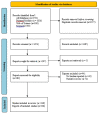Mapping Evidence on the Burden of Breast, Cervical, and Prostate Cancers in Sub-Saharan Africa: A Scoping Review
- PMID: 35784211
- PMCID: PMC9246362
- DOI: 10.3389/fpubh.2022.908302
Mapping Evidence on the Burden of Breast, Cervical, and Prostate Cancers in Sub-Saharan Africa: A Scoping Review
Abstract
Background: Cancer remains a major public health problem, especially in Sub-Saharan Africa (SSA) where the provision of health care is poor. This scoping review mapped evidence in the literature regarding the burden of cervical, breast and prostate cancers in SSA.
Methods: We conducted this scoping review using the Arksey and O'Malley framework, with five steps: identifying the research question; searching for relevant studies; selecting studies; charting the data; and collating, summarizing, and reporting the data. We performed all the steps independently and resolved disagreements through discussion. We used Endnote software to manage references and the Rayyan software to screen studies.
Results: We found 138 studies that met our inclusion criteria from 2,751 studies identified through the electronic databases. The majority were retrospective studies of mostly registries and patient files (n = 77, 55.8%), followed by cross-sectional studies (n = 51, 36.9%). We included studies published from 1990 to 2021, with a sharp increase from 2010 to 2021. The quality of studies was overall satisfactory. Most studies were done in South Africa (n = 20) and Nigeria (n = 17). The majority were on cervical cancer (n = 93, 67.4%), followed by breast cancer (67, 48.6%) and the least were on prostate cancer (48, 34.8%). Concerning the burden of cancer, most reported prevalence and incidence. We also found a few studies investigating mortality, disability-adjusted life years (DALYs), and years of life lost (YLL).
Conclusions: We found many retrospective record review cross-sectional studies, mainly in South Africa and Nigeria, reporting the prevalence and incidence of cervical, breast and prostate cancer in SSA. There were a few systematic and scoping reviews. There is a scarcity of cervical, breast and prostate cancer burden studies in several SSA countries. The findings in this study can inform policy on improving the public health systems and therefore reduce cancer incidence and mortality in SSA.
Keywords: Sub-Saharan Africa; breast cancer; burden; cervical cancer; prostate cancer.
Copyright © 2022 Musekiwa, Moyo, Mohammed, Matsena-Zingoni, Twabi, Batidzirai, Singini, Kgarosi, Mchunu, Nevhungoni, Silinda, Ekwomadu and Maposa.
Conflict of interest statement
The authors declare that the research was conducted in the absence of any commercial or financial relationships that could be construed as a potential conflict of interest.
Figures





References
Publication types
MeSH terms
LinkOut - more resources
Full Text Sources
Medical
Research Materials
Miscellaneous

